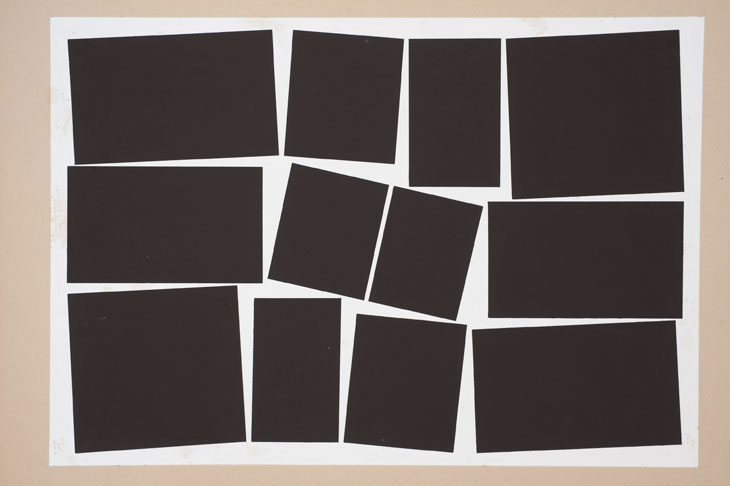A young boy, maybe six or seven years old, jumps into a wooden box filled with foam cubes. He squeals: ‘I could stay here my whole life!’ I agree. We are in Eden, literally – Eden is the title of an installation by Brazilian artist Hélio Oiticica, a sprawling, sand-filled playground for all ages, dotted with various structures where visitors can read, listen to music or jump into boxes filled with foam or grass. First created in 1969 for a solo exhibition at London’s Whitechapel Gallery, the installation has been reconstructed at the Whitney Museum of American Art in New York, where it is currently on show as part of a touring US retrospective of Oiticica’s brief but dazzling career.
Alongside Eden, both today at the Whitney and in the ‘Whitechapel Experience’ of 1969, is a reconstruction of Tropicália (1967), the installation for which Oiticica is perhaps best known. Replete with tropical plants, signal-receiving television sets and live parrots, the work was constructed as a meditation on the myth of a ‘pure’ national identity – its title, a word invented by Oiticica, was to become to the name of a long-lasting cultural movement in Brazil that embraced fusions of native and foreign influences. Together, the two installations aptly represent one of Oiticica’s central principles: the notion of ‘creleisure’, another of the artist’s many neologisms. For Oiticica, leisure – sheer fun – was an ethical imperative, a joyful protest against the oppressive realities of life in his home country, which had been under military dictatorship since 1964.
Eden (1969), Hélio Oiticica: installation view at Whitechapel Gallery, London, 1969. Collection of César and Claudio Oiticica. © César and Claudio Oiticica

Significant as these two works are, both within Oiticica’s oeuvre and in terms of their impact on the trajectories of Brazilian culture and global art history, they comprise only one element of the Whitney’s retrospective, which takes an expansive view of the impressively diverse work Oiticica produced in just two and a half decades from the mid 1950s until 1980. We encounter (and this list is by no means exhaustive) geometric abstraction; kinetic sculpture; political assemblage; wearable garments; films; cocaine-fuelled actions; a number of unrealised publications and architectural projects; and, of course, a series of participatory and audio-visual environments.
The exhibition is subtitled ‘To Organize Delirium’, a phrase that Oiticica’s friend, the poet Haroldo de Campos, used to describe the two warring impulses the artist perceived within his own work: Apollonian structure versus Dionysian chaos. (Friedrich Nietzsche numbered, alongside Kazimir Malevich and Mick Jagger, among the most cherished of Oiticica’s many and varied influences.) ‘To organise delirium’ might also be understood as an apt description of the formidable task of putting together this exhibition, of constructing a coherent narrative from Oiticica’s artistic journey. In a somewhat counterintuitive step, this journey is presented at the Whitney with no clear beginning or end point. Entering the space, visitors are free to choose their own path – a perplexing introduction to an artist whose work is already so complex, layered and disorientating.
Metaesquema 362 (1958), Hélio Oiticica. Carnegie Museum of Art, Pittsburgh; Edward N. Haskell Family Acquisition Fund and A. W. Mellon Acquisition Endowment Fund

The real starting point, chronologically speaking, is the central gallery, which contains Oiticica’s early minimalist abstractions: a series of two- and three-dimensional floating straight-edged shapes. From here, the exhibition carries us through the artist’s career in a kind of outwards spiral. As a spatial metaphor, the spiral actually makes complete sense – as well as echoing the labyrinthine structure of many of Oiticica’s own installations, it both illustrates the widening scope of his progressively interdisciplinary, radical work and reveals a clear through-line of concepts and concerns.
Phenomenology, for example, is there from the very beginning: those first geometric explorations of colour and form reveal the same engagement with the viewer’s sensorial experiences of space and matter as the early ‘penetrables’ – walk-in spaces constructed from monochrome painted boards – and the expanded participatory installations, which Oiticica continued making until the very end of his life. Politics, too, hovers either above or just beneath the surface of all Oiticica’s work, whether in the form of specific reference to Brazilian political figures – as in the boxed shrine to a murdered friend, B33 Box Bólide 18, Homage to Cara de Cavalo (1965–66) – or more generally in the subversive spirit of his years immersed in and documenting his experiences of New York’s sex, drugs and rock’n’roll-filled counterculture from 1970 to 1978.
Hélio Oiticica in front of a poster for Neil Simon’s play The Prisoner of Second Avenue, in Midtown Manhattan, 1972. © César and Claudio Oiticica

Oiticica’s death from a stroke in the spring of 1980 was unexpected, and brought to a halt the career of an artist still in full swing. The final gallery of the exhibition documents the last two years of his life, spent in his birthplace of Rio de Janeiro. In this large, light-filled space, a series of assemblages, composed of found objects and dedicated to people and places, surround one last ‘penetrable’: PN27 Penetrable, Rijanviera (1979), a spare installation furnished only with water, gravel, sand and music, which simultaneously recalls Oiticica’s very first geometric constructions and the increasingly complex sound- and image-filled environments of his later years. By now, the spiralling repertoire of Oiticica’s verbal and visual creations has settled into some kind of order, although you can’t help but wonder what delirious invention he would have dreamt up next.
‘Hélio Oiticica: To Organize Delirium’ is at the Whitney Museum of American Art, New York, until 1 October 2017.



